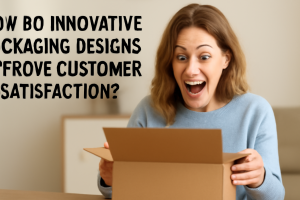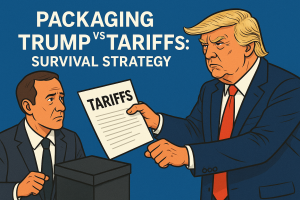Innovative Strategies for Paper Box Manufacturers: Staying Ahead in a Competitive Market
Paper box manufacturers face mounting pressure to balance quality, cost, and sustainability. This article explores how manufacturers can adapt to shifting demands through technology, process optimization, and client-centric approaches. Let’s uncover tactics that redefine modern production.
1. How Can Paper Box Manufacturers Optimize Production Efficiency?
Here’s the reality: Efficiency gaps erode profit margins. Start by auditing workflows. One mid-sized manufacturer reduced waste by 22% after mapping bottlenecks in their die-cutting line.
Automation is non-negotiable. Robotic arms for folding and gluing cut labor costs by 30%. Real-time IoT sensors on machinery predict maintenance needs, slashing downtime by 50%. Lean manufacturing principles, like 5S methodology, further streamline operations.
Table 1: Efficiency Metrics for Manufacturers
| Metric | Industry Average | Top Performers |
|---|---|---|
| Machine Downtime | 12% | 5% |
| Material Waste | 8% | 3% |
| Order Lead Time | 6 weeks | 3.5 weeks |
2. What Technologies Are Transforming the Industry?
The game-changer? AI-driven demand forecasting. By analyzing historical data, manufacturers reduce overstock risks. For instance, a European supplier cut inventory costs by 18% using predictive algorithms.
Digital twin technology simulates production lines virtually. Test process changes without physical trials—saving weeks of R&D. 3D printing for prototyping accelerates design approvals by 40%.
3. How Do Manufacturers Balance Cost and Sustainability?
Let’s debunk a myth: Eco-friendly practices aren’t just ethical—they’re profitable. Switching to recycled fibers lowers material costs by 15%. Solar-powered facilities reduce energy bills by 25% annually.
Waterless printing technology eliminates 95% of water use in coating processes. Clients increasingly pay premiums for carbon-neutral packaging, boosting revenue streams.
Table 2: Cost-Benefit Analysis of Sustainable Practices
| Practice | Initial Cost | Long-Term Savings |
|---|---|---|
| Solar Energy | $120k | $30k/year |
| Recycled Materials | +5% material | -15% waste fees |
| Waterless Printing | $50k setup | -$8k/year (water) |
4. Why Is Customization Critical for Client Retention?
The hidden advantage: Bespoke packaging builds brand loyalty. A cosmetics client saw a 35% sales boost after adopting uniquely shaped boxes.
Invest in modular machinery. One manufacturer halved changeover time by using adjustable die-cutters, enabling smaller batches without MOQ penalties. Digital printing allows last-minute artwork edits—crucial for seasonal campaigns.
5. How Can Manufacturers Mitigate Supply Chain Risks?
A harsh truth: Single sourcing is a liability. Diversify raw material suppliers across regions. During the 2021 cardboard shortage, agile manufacturers with backup suppliers maintained 95% on-time delivery.
Blockchain enhances transparency. Track materials from forest to factory, assuring clients of ethical sourcing.
Table 3: Risk Mitigation Strategies
| Risk | Solution | Outcome |
|---|---|---|
| Material Shortages | Multi-region suppliers | 90% supply continuity |
| Logistics Delays | Nearshoring production | 30% faster shipping |
| Price Volatility | Fixed-price contracts | 12-month cost stability |
6. What Role Does Client Collaboration Play?
The breakthrough: Co-designing packaging strengthens partnerships. Host quarterly workshops to align on trends like unboxing experiences. One manufacturer developed tear-resistant boxes for e-commerce clients, reducing returns by 17%.
Dedicated account managers using CRM tools improve responsiveness. Track client feedback loops to refine offerings.
7. How Are Manufacturers Adapting to E-Commerce Demands?
The e-commerce edge: Reinforced corners and lightweight designs dominate. Amazon’s “Frustration-Free Packaging” standards require drop-test certifications—manufacturers meeting these gain preferential vendor status.
Table 4: E-Commerce Packaging Requirements
| Requirement | Specification |
|---|---|
| Drop Test | Survives 1.2m falls |
| Weight Limit | <500g for small parcels |
| Assembly Time | <30 seconds per box |
8. What Innovations Are Emerging in Material Science?
Beyond cardboard: Mycoprotein-based packaging decomposes in 30 days. Nano-coatings repel water and grease, ideal for food delivery. Price remains a hurdle—biodegradable options cost 20% more, but client demand grows 12% annually.
9. How to Train Teams for Future-Readiness?
Upskill or fall behind: Cross-train staff on AI tools and automation. Partner with tech institutes for certifications. One factory boosted productivity by 18% after VR-based safety training.
10. What Metrics Should Manufacturers Prioritize?
Data-driven wins: Track OEE (Overall Equipment Effectiveness). Top performers hit 85% OEE via real-time monitoring. Client retention rates and NPS scores reveal service quality gaps.
FAQ Section
Q1: How do manufacturers handle small-batch orders?
Through modular production lines and shared tooling to minimize costs.
Q2: What certifications attract global clients?
ISO 14001 (environmental management) and SMETA audits (ethical sourcing).
Q3: Can manufacturers reuse production waste?
Yes—shredded cardboard scraps are recycled into padding or new sheets.
Q4: How to manage color consistency across batches?
Spectrophotometers ensure Pantone matches within ΔE <2.
Q5: What’s the ROI of automation?
Typically 18–24 months via labor savings and defect reduction.
Conclusion:
Paper box manufacturers must innovate relentlessly—automate processes, adopt sustainable materials, and deepen client collaboration. Prioritize technologies like AI and blockchain to future-proof operations. For actionable insights, download our Manufacturer’s Playbook or join industry webinars. In a market where adaptability defines survival, stagnation isn’t an option.




